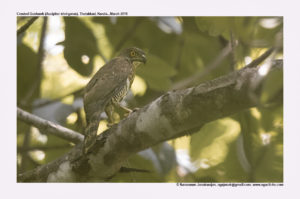Crested Goshawk

Crested Goshawk Accipiter Trivirgatus
Etymology:
- Accipiter : Latin word accipiter- hawk derived from accipere to grasp
- Trivirgatus: Latin word Tri – Three , Virgatus -Straight Crests
Vernacular Names: Hindi: Gor besra, Manik besra, Koteswar, Cachar: Hagrani daoling, Nepal: Churiari, Jamal kanthi, Jurye, Ta: Valluru, Te: Kokila dega, Sinh: Ukussa, Kurulla goya, Mar: Turewala Sasana
Distribution in India: Resident of Himalayan foothills and North East India.
Description: Size of 30–46 cm; Wt. of 224–450 g, wingspan of 68–76 cm for male and 78–90 cm for female. It is a medium-sized Accipiter, with short wings; short, pointed crest usually depressed and not visible; blackish crown; grey face; wide dark mesial stripe on white throat ; rufous breast with dark streaks; whitish abdomen and flanks with brown to chestnut barring; tail with dark and pale bands of roughly equal width. The female 8–22% larger than male and tends to be browner on head and nape, paler on back and have less rufous coloration on chest, but very difficult to separate sexes unless seen side by side. The eyes are yellow to reddish orange or orange-yellow; cere is greenish yellow to yellow; feet are yellow to orange-yellow. The juvenile is similar to adult but crown is blackish-brown with buff markings; abdomen is streaked; back is grey-brown, eyes are brown or paler yellow; cere is greenish grey to greenish; feet is dull yellow.
Habitat: It is found in deciduous and evergreen forest from humid lowlands to foothills. It favours forests with scattered openings and stream side vegetation; near villages, forested gardens, and cultivated areas. It is found from sea-level to 2400 m..
Food Habits: It eats small mammals, lizards, frogs, birds, and large insects. The prey size and type vary geographically owing to differences in body size among subspecies. The prey is typically captured after short, rapid attack launched from concealed perch, usually inside forest.
Breeding Habits: They breed in Mar–Jul in India; Feb–Jul in Sri Lanka; Jan on Sumatra; Dec–Mar in Java; Feb on Borneo; late Jan–late Jul in Taiwan. The breeding display is a spectacular winnowing display flights by male, gliding over territory with white undertail coverts widely spread and wings drooped, before diving steeply back down into canopy. A large nest is built by the breeding pair above the ground in a large tree. The nest is lined with green leaves and placed near a creek or pond. They lay a clutch of 2-3 eggs. The incubation period is 34–39 day. The fledgling period is 45-48 days.